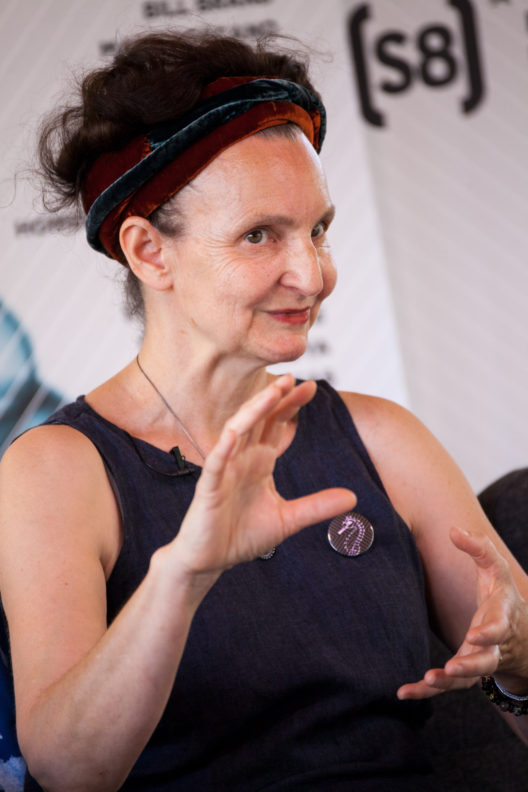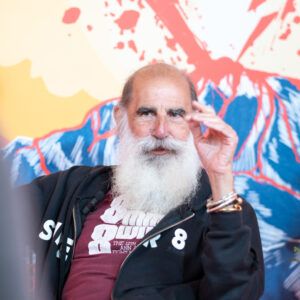
Painting and Natural History
When I was making artwork, originally I was interested in painting. But then I felt that painting was too static, and somehow the end result was not reflective of all the processes of thinking that were going on in my mind, obviously, in my world. I looked to someone like Borges, as a writer, and that is the kind of quality that I was really fascinated by, that there are elements of fiction, of observation, references to other artworks… And for me, that was very much how film felt in my case: to me, it was like daydreaming. And somehow, references to all of those qualities or specifically painting, or literature, I was considering… it’s like the colours of my thoughts, trying to distil that. But, at the same time, it doesn’t necessarily matter to other people that I have all those references, but it matters very much to me, that I have been able to bring those references to the world, like in the landscape of The Fall of Icarus, this is a painting by Bruegel, and it’s always fascinated me, so… by making a film about that, and using natural history images to do so, natural history images of a grasshopper that seems to fly but also seems to fall, I feel like that image somehow is one that I see around me, and also… you know what is that meaning of something that has ambition, that tries to live beyond… maybe beyond the everyday? I didn’t see it as a catastrophic result of ambition going awry, but more like a trying… to maybe look for more in life. And that was maybe what I was trying to do as an artist, too: make that leap… and possibly fail [laughs]. That’s perhaps an example of how I was thinking about what that painting’s meaning is, and then perhaps reflected in something very… everyday, like the fallen flight of a grasshopper.
The Alchemy
The idea that there is this hidden image, you know, the latent image in the photographic process seems to be magical to me, and it seems to partly be science. And I think it’s really through the playful notes of working with materials that I find or have found the communion with the early alchemists. Playfully trying to achieve something and distil, more than anything else, distil all of these thoughts into something more, or something special. And that’s been my interest, and then I’m also fascinated by the drawings of process that the early alchemists made, like Robert Fludd, to sort of explain that process, so there was always a visual component to the literature of alchemy. And those drawings themselves then became fascinating to me, the qualities they found in trying to express elements or elementary things in their world. They have some resonance with scientific imagery too, so early scientific photography combined with those images of alchemy have been very important, and probably I just engage in this somewhat lonely or alone experience of making work. I feel that I have that kind of connection to that world of the alchemists.
The Magic Lanterns
I think it was a gradual falling in love with magic lanterns, which actually reminded me that I had one as child, a very plasticky one, that sort of died because it was battery-operated. I began to be interested in thinking about ways of making movie illusions that did not rely on mechanics, and then I thought about the Kodak light projectors, but these are very mechanic, too, “clic, clic, clic”. But still, I was kind of fascinated in the early history of moving illusions, in what were those original illusions like, and what were the movements that we have now lost, because we are so caught up in the repetition of a frame, and the reduction to just one frame. So, from there grew this interest in the magic lantern, and also because of its projected light, and that wonderful feeling of stained glass, and the image coming out of darkness, which I always was in love with. But there was also a possibility for an intimate storytelling. Intimate like… people would have magic lanterns at home, and project them maybe onto a curtain, or onto a wallpaper… and those become kind of a story or fabric of people’s lives. I began then to write, thinking what can I write, how can I make that stories? And to me… that seemed really fascinating and wonderful. And then, from that, I developed this techniques of hand-processing lantern slides.
The Narratives of the Lantern
For a long time, I was interested in making works that did not rely on language at all, that were really very much like the daydreams that I feel exist in the visual realm for me, outside of language. But with the magic lantern I wanted to return to that idea of “story”, specifically. And I just began to write. I think that I had written for some of the other films, that the language was there in a way, but this time it just came to me when I was looking to the magic lantern, that I wanted to write a story that would be involved with the magic lantern. And it was encouraged by the ideas that I was having at that time, I was reading W. H. Hudson, who was this fantastic ornithologist –because I have this interest in natural history– who spent most of his life writing about birds of Argentina from a distance of living in England. So he had a kind of natural history that was really reliant on his fantastic memory, but possibly a little bit of imagination, too. And I began to read his work, so I began to engage in his memory and his fantasies about the birds that he had seen. And I thought… this to me seems that it can become a lecture of a kind, and so the magic lantern is greatly associated with early illustrated lectures and the stories that emerge from those thoughts. And I’ve just continued to be writing for… The Tears of a Mudlark, and now I have a third lantern show that I’m writing for. I think that’s a relatively new, but an exciting departure to write about things.





